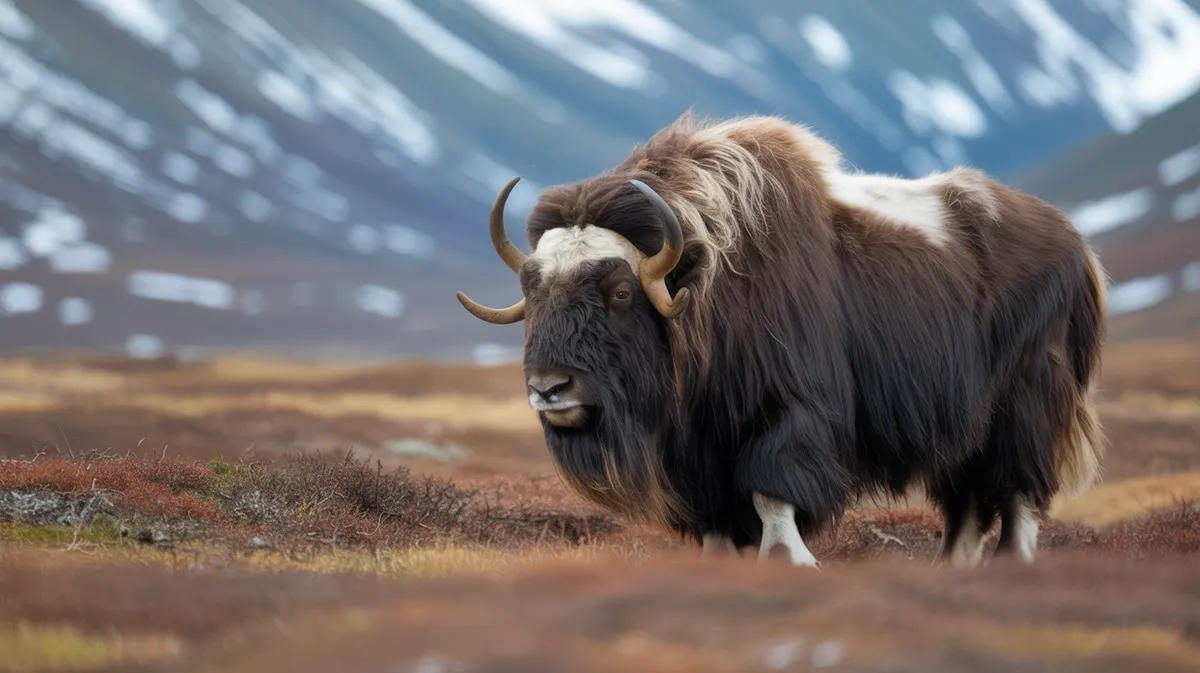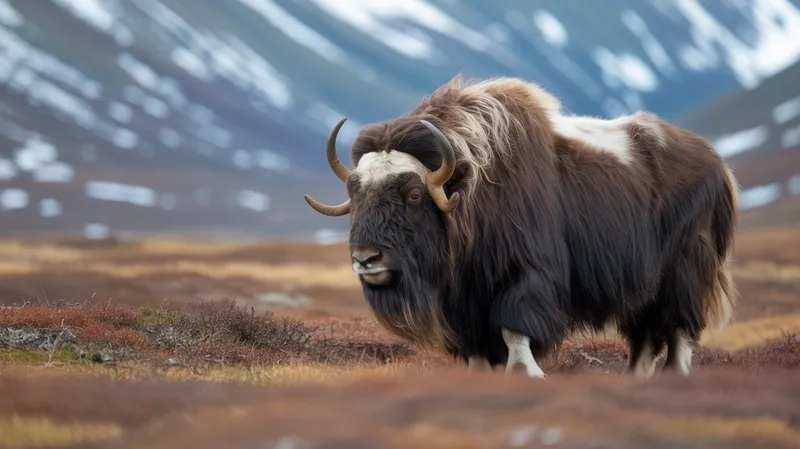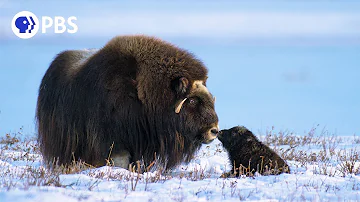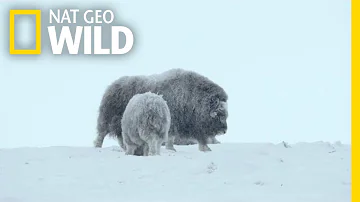
Muskox
Ovibos moschatus

Meet the Muskox
The muskox is a shaggy, hoofed mammal native to the Arctic tundra, recognized for its impressive curved horns and thick, insulating coat. Adapted to some of the harshest climates on Earth, it can withstand extreme cold thanks to its dense underwool called qiviut. Muskoxen are social animals, living in herds that provide protection against predators such as wolves. During confrontations, they famously form defensive circles with their horns facing outward to shield their young.
Classification
Mammal
Habitat
Arctic tundra
Diet
Herbivore
Lifespan
12-20 years
Conservation
Least Concern
Weight
180–410 kg (400–900 lbs)
📖Fascinating Facts
Ultra-Warm Coat
The muskox's coat includes a layer of qiviut, one of the finest and warmest natural fibers, allowing survival in temperatures as low as –40°C (–40°F).
Defensive Circles
When threatened by predators, muskoxen form a circle or line with their horns facing outward, protecting calves in the center.
Musky Scent
Males produce a strong musky odor from glands near their eyes during the rutting season to attract females and deter rivals.
📋Detailed Description
The muskox (Ovibos moschatus) is a robust Arctic ungulate distinguished by its stocky build, short legs, and a dense, two-layered coat. Adults typically weigh between 180 and 410 kg (400–900 lbs), with males being larger than females. Their most striking anatomical features are the broad, curved horns present in both sexes, which are used for defense and dominance displays. The outer coat consists of long, coarse guard hairs that reach almost to the ground, while the undercoat, known as qiviut, is one of the finest and warmest natural fibers, providing exceptional insulation against subzero temperatures. Muskoxen are highly social, forming herds of 10–20 individuals in winter, though larger aggregations of up to 70 can occur in summer. Their social structure is matriarchal, with dominant females leading the herd, while males compete for breeding rights during the rut. Muskoxen are primarily grazers, feeding on a variety of Arctic vegetation, including sedges, grasses, mosses, and willows. They exhibit a unique defensive behavior, forming protective circles or lines with adults facing outward and calves in the center when threatened by predators such as wolves or bears. Their life expectancy in the wild is typically 12–20 years, though predation and harsh winters can reduce survival rates.
💡 Did you know?
Male muskoxen emit a strong musky odor during the mating season, which is how the species got its name.
🔬Research & Sources
Wikipedia Summary
The muskox is a hoofed mammal of the family Bovidae. Native to the Arctic, it is noted for its thick coat and for the strong odor emitted by males during the seasonal rut, from which its name derives. This musky odor has the effect of attracting females during mating season. Its Inuktitut name "umingmak" translates to "the bearded one".
Last Modified: 6/8/2025
🎭Behavior & Social Structure
Muskoxen are diurnal, with most feeding occurring during daylight hours, especially in the brief Arctic summer when food is abundant. They use their hooves and strong forelimbs to dig through snow to access buried vegetation in winter. Social interactions are complex; females establish dominance hierarchies, while males engage in ritualized head-butting contests during the rut, which can involve charging at speeds up to 60 km/h (37 mph). Outside the breeding season, males may form bachelor groups or remain solitary. Herd cohesion is strong, with vocalizations and body language used to maintain group structure and alert others to danger. Calves are highly dependent on maternal care and are protected by the entire herd. Muskoxen migrate short distances seasonally, seeking areas with less snow accumulation and better forage availability.
👶Reproduction & Life Cycle
The breeding season, or rut, occurs from late July to early September. Dominant males mate with multiple females after intense competition and displays of strength. Females experience a gestation period of approximately 8–8.5 months, giving birth to a single calf (rarely twins) between April and June, coinciding with the onset of the Arctic spring. Calves are precocial, able to stand and follow the herd within hours of birth. Maternal care is intensive during the first few weeks, with calves nursing for up to two months but beginning to graze within a week. Sexual maturity is reached at 2–4 years, though males may not successfully breed until they are older and able to compete with dominant bulls. Calf survival is heavily influenced by weather conditions and predation pressure.
🛡️Adaptations & Survival
Muskoxen are superbly adapted to Arctic environments. Their qiviut underwool provides insulation superior to sheep's wool, while the long guard hairs repel moisture and wind. Their compact body shape minimizes heat loss, and their short, stout legs reduce surface area exposed to the cold. Large nasal passages warm incoming air before it reaches the lungs. Behavioral adaptations include huddling for warmth and forming defensive formations against predators. Their digestive system is specialized for extracting nutrients from coarse, fibrous Arctic plants, with a large rumen and slow fermentation process. Seasonal metabolic adjustments allow them to conserve energy during winter scarcity.
📚Research Sources
🎨Cultural Significance
Muskoxen hold deep significance for Arctic Indigenous peoples, such as the Inuit and Inuvialuit, who refer to them as 'umingmak'—'the bearded one.' Traditionally, muskoxen provided meat, hides for clothing and shelter, and qiviut for exceptionally warm garments. Their defensive behavior and resilience are celebrated in folklore and symbolism, often representing strength and communal protection. In modern times, qiviut is a valuable, sustainable fiber harvested from shed underwool, supporting local economies and traditional crafts.
🔬Recent Research & Discoveries
Recent research has focused on the impacts of climate change on muskox health, nutrition, and population dynamics, with studies documenting increased parasite loads and disease outbreaks (e.g., lungworm, Erysipelothrix rhusiopathiae) linked to warming temperatures. Genetic studies have revealed low diversity in some populations, raising concerns about long-term viability. Conservation genetics and reintroduction programs are ongoing, particularly in areas where muskoxen were extirpated in the 19th and 20th centuries. Satellite tracking and remote sensing are being used to study seasonal movements and habitat use. There is also growing interest in the potential of muskoxen as indicators of Arctic ecosystem health.
🎥Wildlife Videos

Musk Oxen Vs Arctic Wolves | Animal Super Parents | BBC Earth
In the Arctic tundra, a herd of musk ox are up against a pack of hungry wolves. Will the parents successfully protect their calves ...
BBC Earth

Newborn Muskox's First Day
Within hours of being born, this calf is ready to explore. Please LIKE and SUBSCRIBE if you enjoyed it! **More info & videos ...
Nature on PBS

Profiles of Nature: The Muskox (full documentary)
Early 90's Discovery Channel VHS rip.
Forgotten Documentaries

Muskox: The Kings of the Arctic Plains
As the wind howls across the Arctic tundra, a mighty creature roams free. It stands tall, with a thick coat of fur and sharp, curved ...
KiloFact - Interesting Facts

The Return Of Musk Ox. Siberia. Arctic areas. BUSHCRAFT in the tundra. Survival
The experiment of repopulating the Taimyr Peninsula with the musk ox, which began thirty years ago, has enriched Arctic ...
Vasiliy Sarana & Wildlife adventures & Ukraine

For Musk Ox in Siberia, It's a Cold Life | Wild Russia
About National Geographic Wild: National Geographic Wild is a place for all things animals and for animal-lovers alike. Take a ...
Nat Geo Animals
🌍Habitat Information
The Muskox typically inhabits Arctic tundra environments. Muskoxs have adapted to their environments with specialized features and behaviors.
Primary Habitat:
Arctic tundra
More detailed habitat information will be available soon.
🛡️Conservation Status
The Muskox is currently classified as Least Concern. Conservation efforts are crucial for preserving this species for future generations.
Common Threats:
- 🏠Habitat loss and fragmentation
- 🌡️Climate change impacts
- 🎯Hunting and poaching
- 🏭Human-wildlife conflict
⚠️Threats & Conservation Challenges
While currently classified as Least Concern by the IUCN, muskoxen face several threats. Climate change poses the most significant long-term risk, altering snow and ice conditions, affecting forage availability, and increasing disease transmission. Extreme weather events, such as rain-on-snow, can create ice layers that prevent access to food, leading to starvation. Predation by wolves and occasionally bears remains a natural mortality factor, especially for calves. Human impacts include habitat disturbance from resource extraction, increased disease risk from contact with domestic animals, and historical overhunting. Some reintroduced populations remain vulnerable due to limited genetic diversity and small population sizes.
🔬Scientific Classification
Scientific Name
Ovibos moschatus
Classification Hierarchy
🔍 About Taxonomic Classification
Taxonomic classification is a hierarchical system used by scientists to classify and organize living organisms based on shared characteristics and evolutionary relationships.
The system moves from broad categories (Kingdom) to increasingly specific ones, with each animal's scientific name typically consisting of its Genus and species.
📝Community Notes
Share your observations and insights about the Muskox with our community of wildlife enthusiasts.
Join Our Community
Sign in to share your observations and connect with fellow wildlife enthusiasts.
Sign In to ContributeNo community notes yet
Be the first to share your observations about the Muskox!
Explore Muskox
Select a tab above to learn more about this amazing animal.
📸Photo Gallery
No photos available for this animal yet.
🌟Discover More Wildlife
Continue your journey of discovery with more fascinating animals from our database
